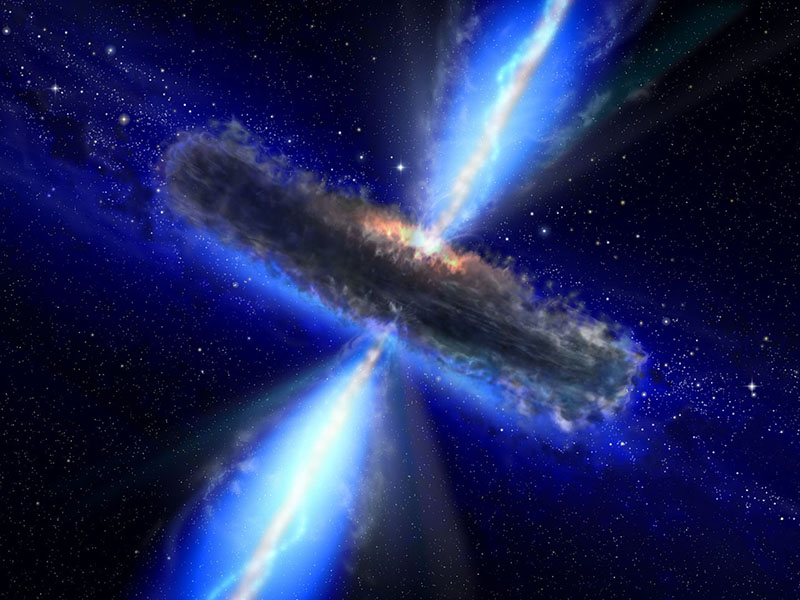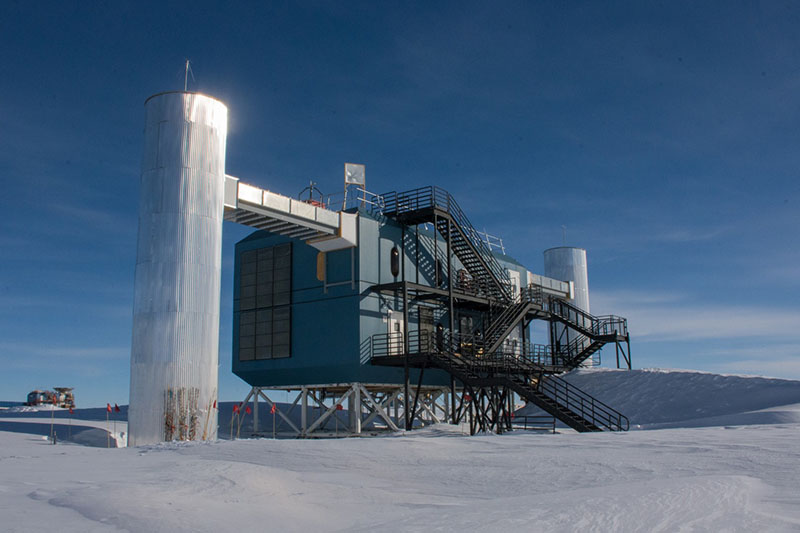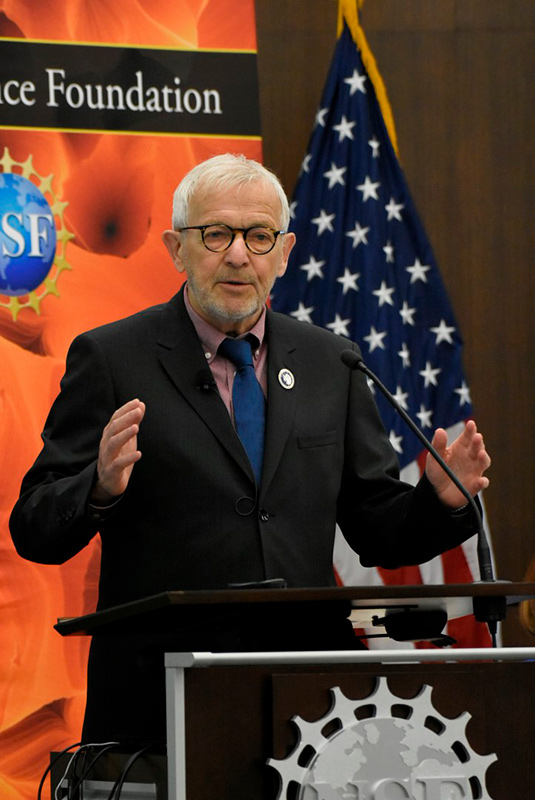Neutrinos Point the Way to Cosmic RaysAstronomers Identify Source of Cosmic Rays Using Neutrinos and Gamma RaysPosted July 12, 2018
Using data gathered by the National Science Foundation- (NSF) funded IceCube Neutrino Observatory at the South Pole, scientists have for the first time identified a super massive black hole as the source of some of the highest energy cosmic rays. 
Photo Credit: Icecube/NSF
As the neutrino passed through the ice below the South Pole on September 22, 2017, it emitted a faint trail of light along its track, which IceCube’s detectors picked up (not to scale).
In a pair of papers published in the July 13 edition of Science, astronomers reported that working in conjunction with ground-based and space-based gamma ray telescopes they were able to pinpoint a supermassive black hole at the heart of a distant galaxy as the source of two neutrino emissions that also produced extremely energetic cosmic rays. It’s the first time astronomers have been able to definitively pinpoint an astronomical phenomena powerful enough to accelerate charged particles up to some of the highest energies ever detected, more than a million times more energetic than the best man-made particle accelerators. “We don’t know where they are produced, how they are accelerated,” said Francis Halzen, a University of Wisconsin-Madison professor of physics and lead scientist for IceCube. “This is probably the oldest problem in astronomy.” That the detection was confirmed by other instruments, including an orbiting telescope operated by NASA, is a demonstration of the value of the emerging field of "multi-messenger astronomy," which describes the ability to marshal instruments globally to make and verify discoveries by combining data from messenger signals that reveal information about the universe. 
Photo Credit: ESA/NASA, the AVO project and Paolo Padovani
This artist's rendering of a supermassive black hole found at the center of an active galaxy show the energetic jets emitted from around it's center. When these jets are pointed directly at Earth, astronomers refer to it as a blazar because they’re so bright.
"The era of multi-messenger astrophysics is here," said NSF Director France Córdova. "Each messenger -- from electromagnetic radiation, gravitational waves and now neutrinos -- gives us a more complete understanding of the universe, and important new insights into the most powerful objects and events in the sky. Such breakthroughs are only possible through a long-term commitment to fundamental research and investment in superb research facilities. "Scientists have known about cosmic rays since 1912 but pinpointing their origin is difficult. The term “cosmic rays” is a bit of a misnomer. They are in fact charged particles with tremendous amounts of energy that speed through the universe at high speeds. This charge, which allows them to be accelerated to their incredible energies, also means they are deflected by the magnetic fields that permeate the universe, making it impossible to trace their paths back to their origins. Neutrinos, ghostly particles with nearly no mass that travel at almost the speed of light, are neutral and aren’t affected at all by magnetic fields. Scientists can trace their paths directly back to their source. Likewise, gamma rays, essentially a kind of high-energy light, also travel through the universe unperturbed by magnetic fields. Neutrinos, gamma rays and cosmic ray particles are produced in the same powerful nuclear reactions so likely where one originates, so do they all. “We [are] looking at the first source of not only high-energy gamma rays but also neutrinos, and that means that this source is also [a] source of cosmic ray particles,” said Albrecht Karle, another UW-Madison physics professor and senior IceCube scientist. NSF’s Office of Polar Programs, which manages the U.S. Antarctic Program, and the Physics Division in its Mathematical and Physical Sciences Directorate jointly oversee the operation of the NSF’s IceCube, the world’s largest neutrino detector. Located at NSF’s Amundsen-Scott South Pole Station, the observatory was designed specifically to observe and track high-energy neutrinos. A neutrino barely interacts with normal matter and can pass through many miles of solid material completely undisturbed. However, if on the rare occasion it precisely strikes the nucleus of an atom, it will emit a tiny flash of light. IceCube has 5,160 sensitive light detectors buried under more than a kilometer of clear ice at the South Pole, using a square kilometer of natural ice itself a detection medium to track the energy and direction of neutrinos. Though highly sophisticated, the neutrino observatory was only the first part of the story. 
Photo Credit: Mike Lucibella
The IceCube Lab at the South Pole sits atop more than a mile of solid ice.
The researchers hailed this discovery as a big success for “Multi-Messenger Astronomy” an emerging field of astronomy that uses multiple telescopes and different methods to observe the sky to learn as much as possible about an astronomical event. “This is the first event that is really multi-messenger,” Halzen said. “This whole episode would not have happened without multiple telescopes. Every telescope individually would have missed the event.” On September 22, 2017, IceCube detected a high-energy neutrino passing through the ice at the heart of the detector. “The event that triggered this was a beautiful event,” Karle said, adding that they were able to track the neutrino for more than a kilometer, about 2,000 meters under the ice. “That is like the sweet spot, it’s a perfect condition.” Within 43 seconds, the observatory’s computer calculated the particle’s track and the general direction in the sky it came from and sent out an alert out to telescopes around the world to train their eyes on a particular set of coordinates in the sky. 
Photo Credit: IceCube Collaboration/NSF
Drawn to scale , this artist’s rendering gives a sense of scale as to how deep IceCube's detectors are buried below the surface of the ice as the September 22, 2017 neutrino passes through the DOMs. The detector itself takes up about a cubic kilometer of ice.
“We then sent the coordinates, with an astronomical telemetry to all the telescopes, and then they looked at the direction that we pointed them and that’s how we converged on this galaxy,” Halzen said. The point on the sky the neutrino came from was a distant galaxy named TXS 0506+056. It’s a galaxy about 12 billion light-years away with an active, enormous supermassive black hole at the center of it. The black hole is what astronomers call a “blazar” because the area around its event horizon emits enormous amounts of energy in huge jets that happen to be pointed directly at Earth, making it appear extra bright in the sky. The orbiting Fermi Gamma-ray Space Telescope had been conducting an all-sky survey over the same region and saw a gamma-ray flare at the same time. Over the next several nights, the ground-based Major Atmospheric Gamma Imaging Cherenkov (MAGIC) telescope in La Palma, Spain, trained its detectors at the same spot in the sky, collecting detailed images of the source. With the combined gamma ray observations, the researcher determined that the signal that IceCube saw was from a huge cloud of matter flaring as it fell into the black hole. 
Photo Credit: NSF
Astrophysicist Francis Halzen describes the discovery at the press conference announcing the results of the team’s work.
“The power of the accelerator is supplied by this supermassive black hole that was in a flaring state,” Halzen said. “That increased the power it put out by a factor of six in the last few months.” The team reached out to the gamma ray telescopes in part because while IceCube can trace the tracks of neutrinos to a relatively small patch of sky, it’s still pretty big astronomically speaking. The observatory can pinpoint the source of a neutrino to within a patch of sky is still about half a degree each side, or an area roughly the size of the full moon, which is too wide to definitively identify a precise source. “For that purpose we would need an angular resolution that is 1000 times better, because there are many galaxies in a circle of one degree,” Karle said. “In order to identify sources, we need the help of other astronomical instruments, telescopes.” The blazar TXS 0506+056 had been known to astronomers for years, but is only one of tens of thousands of such galaxies in the sky. While the gamma-ray telescopes were observing the blazar, Halzen and his team went through previous neutrino observations over the last decade of IceCube’s operation and discovered a much bigger flare from three years earlier that also seemed to originate from the same patch of sky. “Then we looked back in our own data and we found this huge flare in 2014, which made the thing that happened in September of last year look meaningless,” Halzen said. “We basically had one neutrino [in 2017]. In 2014 we had 19 in 150 days.” The cluster of neutrinos in 2014 was biggest collective signal the observatory had ever seen, and was likely the result of an even more massive cloud of matter falling into the black hole. This additional event further confirmed that TXS 0506+056 is continuously producing high-energy cosmic rays as matter falls into its black hole. The team will continue to review their data to see if there is previous evidence of other neutrino flares from other active galaxies. NSF-funded research in this story: Francis Halzen, the University of Wisconsin-Madison, Award No. 1600823 and Award No. 1607644. |
"News about the USAP, the Ice, and the People"



For USAP Participants |
For The Public |
For Researchers and EducatorsContact UsU.S. National Science FoundationOffice of Polar Programs Geosciences Directorate 2415 Eisenhower Avenue, Suite W7100 Alexandria, VA 22314 Sign up for the NSF Office of Polar Programs newsletter and events. Feedback Form |


